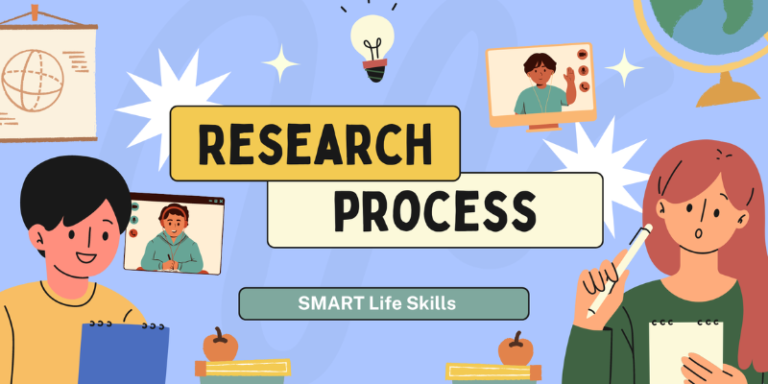Research is a systematic and structured process employed to investigate and interpret information, providing solutions to problems or offering insights into a particular subject. It is fundamental to the advancement of knowledge across various disciplines, whether in the sciences, humanities, or social sciences. A well-organised research process is crucial for delivering accurate and reliable results, which can then be used to inform decision-making, policy formulation, or further academic inquiry. This process generally consists of several key stages: formulating and clarifying the topic, reviewing the literature, designing the research, collecting data, analysing data, and writing up the results. Each step builds on the previous one, ensuring a coherent flow that leads to a well-founded conclusion.
1.0 Formulating and Clarifying the Research Topic
The first step in the research process is to develop a clear and concise research topic. A well-defined research topic serves as the foundation for the entire study, helping to guide decisions throughout the process. According to Saunders, et al. (2019), a clear research topic enables the researcher to focus on the specific issue at hand, ensuring relevance, clarity, and precision.
Formulating a research topic involves not only selecting a subject of interest but also narrowing it down to a manageable scope. A topic that is too broad can lead to difficulties in managing the data and research workload, while a narrow topic may result in limited findings and lack of depth. At this stage, researchers should engage in preliminary reading and discussions to refine their ideas and ensure the research’s relevance to their field of study. Additionally, the topic should be something that sparks the researcher’s interest, as this will sustain motivation throughout the often lengthy research process.
Moreover, the researcher must ensure that their topic is researchable within the time frame, resources, and methodologies available. Developing clear and specific research questions or hypotheses helps guide the research focus and sets boundaries for the study. These questions will shape the objectives of the research, guiding the researcher on the type of information required.
2.0 Reviewing the Literature
Once the topic is defined, the next step is to review the existing literature. The literature review is a crucial part of the research process as it allows researchers to understand what has already been studied, identify gaps in the research, and position their work within the broader academic context. The purpose of this stage is to ensure that the researcher is not duplicating previous studies and to establish a foundation of existing knowledge upon which new findings can be built.
A literature review involves sourcing information from various types of resources, such as textbooks, academic journals, conference papers, and credible online sources. Bryman and Bell (2015) highlight that a thorough literature review enables researchers to sharpen their focus on unresolved issues and further theoretical understanding. By critically evaluating past studies, researchers can identify areas that require additional exploration or methodology improvements.
In conducting a literature review, it is important to use up-to-date and peer-reviewed sources, as these provide the most reliable evidence. Additionally, the review should be systematic and comprehensive, covering key debates, theories, and methodologies relevant to the research topic. It is also essential to critique the sources rather than simply summarise them. This critical evaluation helps to demonstrate an understanding of the subject and shows how the research will contribute new insights to the field.
3.0 Designing the Research
Designing the research is the third step in the process, and it involves selecting the appropriate methodology to address the research question or hypothesis. There are two primary types of research methodologies: qualitative and quantitative. Qualitative research focuses on exploring phenomena through non-numerical data, such as interviews, case studies, and observations. On the other hand, quantitative research involves the collection and analysis of numerical data, often using statistical methods to test hypotheses.
The choice between qualitative and quantitative methods depends on the nature of the research question and the type of data required. Saunders et al. (2019) suggest that the research design should align with the research objectives. In some cases, researchers may use a mixed-methods approach, combining both qualitative and quantitative techniques to gain a more comprehensive understanding of the research topic.
Additionally, the researcher must decide on the type of research design, whether it will be exploratory, descriptive, or explanatory. Exploratory research seeks to investigate new phenomena or explore an area where little is known. Descriptive research provides a detailed account of a specific topic, often focusing on the “what” of the situation. Explanatory research, meanwhile, seeks to explain relationships between variables and is more focused on understanding cause-and-effect dynamics.
At this stage, ethical considerations must also be addressed, particularly when working with human subjects. Ethical research requires obtaining informed consent from participants, ensuring confidentiality, and minimising any potential harm. Researchers are also obliged to maintain integrity and transparency throughout the research process.
4.0 Collecting Data
Data collection is a critical stage in the research process. The method chosen to collect data will depend on the research design and objectives. Common data collection methods include surveys, interviews, experiments, and observations. For quantitative research, surveys and experiments are typically used to collect numerical data that can be statistically analysed. In contrast, qualitative research often employs interviews, focus groups, and case studies to collect detailed, subjective data.
Creswell (2014) notes that the choice of data collection methods should consider the nature of the research question, the available resources, and the time frame for the study. In quantitative research, it is important to ensure that the data collection process is both reliable and valid. Reliability refers to the consistency of the data collection process, ensuring that the results can be replicated under similar conditions. Validity, on the other hand, ensures that the data accurately reflects the research question and provides a true representation of the subject under investigation.
For qualitative research, data collection involves a more flexible and iterative process. Researchers may conduct interviews with open-ended questions, allowing participants to express their thoughts and experiences freely. In qualitative studies, maintaining the credibility and authenticity of the data is essential to ensuring the validity of the findings.
5.0 Analysing Data
Data analysis is the process of interpreting the data collected to draw meaningful conclusions. In quantitative research, data analysis often involves statistical techniques such as regression analysis, correlation, or hypothesis testing to identify patterns and relationships in the data. These techniques allow researchers to test the validity of their hypotheses and draw generalisable conclusions.
Qualitative data analysis, on the other hand, focuses on identifying themes, patterns, and insights from non-numerical data. Thematic analysis, for example, involves reviewing transcripts from interviews or focus groups to identify recurring themes that provide insight into the research question. Bryman (2016) emphasises that data analysis should be conducted systematically, with researchers maintaining objectivity and avoiding bias.
The results of data analysis should always be related back to the original research questions and objectives. It is important to ensure that the analysis is rigorous and that the conclusions drawn are supported by the evidence. Any limitations or potential biases in the data should also be acknowledged.
6.0 Writing Up
The final stage of the research process is writing up the results. This involves presenting the research findings clearly and logically, ensuring that the structure reflects the research process. Most research reports follow a standard format: introduction, literature review, methodology, results, discussion, and conclusion.
When writing up the research, it is essential to provide a critical evaluation of the findings, discussing how they relate to the literature reviewed and the research objectives. According to Saunders et al. (2019), clarity and coherence in writing are crucial to ensuring that the research is accessible and understandable to the intended audience. It is also important to present the findings in an unbiased manner, acknowledging any limitations or areas for further research.
Finally, the conclusion should summarise the key findings, highlight their significance, and suggest potential areas for future research. By following these steps, researchers can ensure that their work contributes meaningfully to the broader academic community.
References:
Bryman, A., & Bell, E. (2015) Business Research Methods. Oxford University Press.
Creswell, J. W. (2014) Research Design: Qualitative, Quantitative, and Mixed Methods Approaches. Sage Publications.
Saunders, M., Lewis, P., & Thornhill, A. (2019) Research Methods for Business Students. Pearson.













